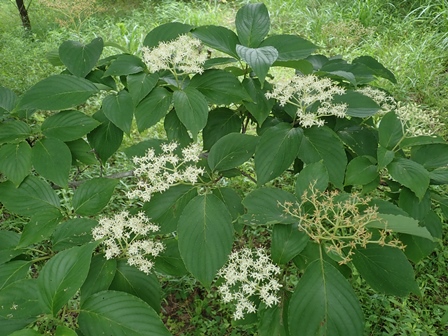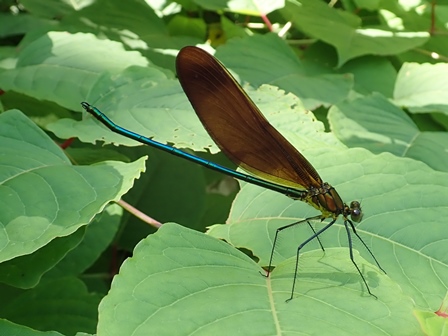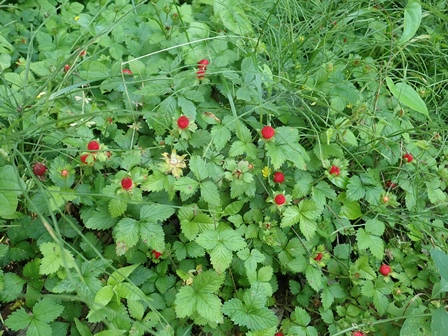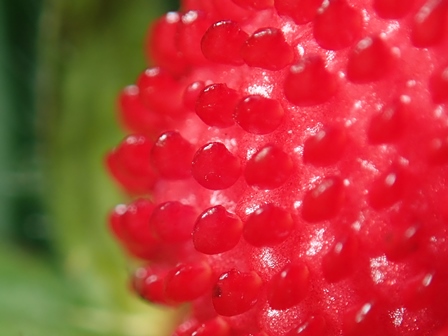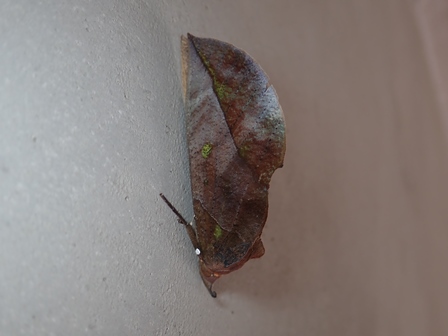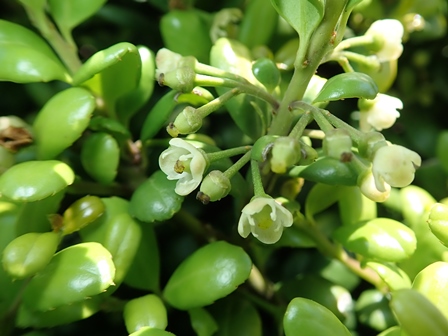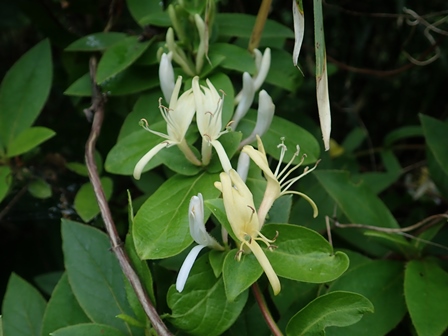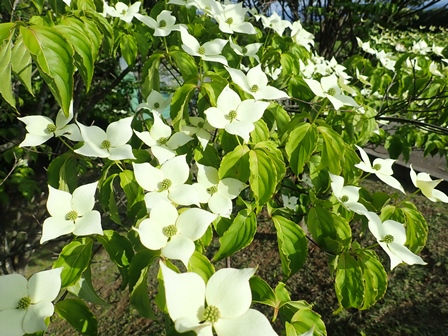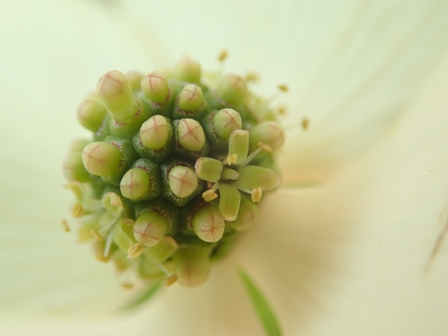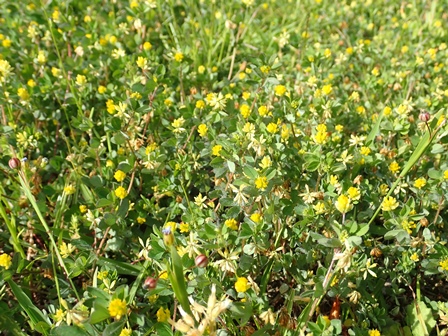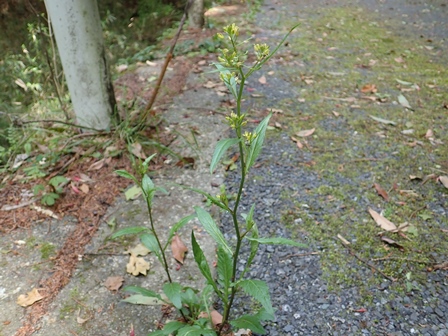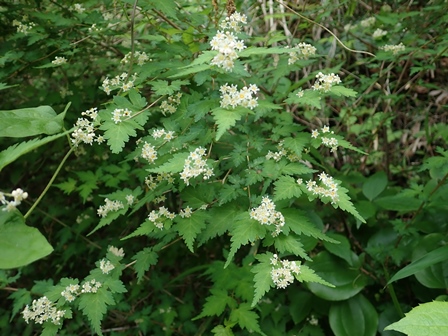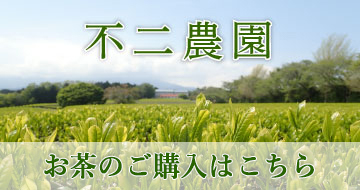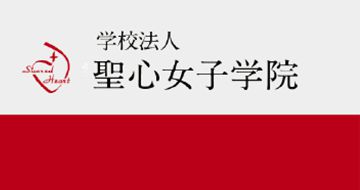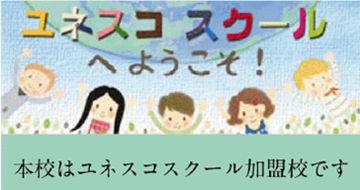フィールド日記
2021.06.15
クマノミズキ
共生の森でクマノミズキが咲いています。花は近縁のミズキととてもよく似ていますが、クマノミズキは葉が1か所から2枚出る対生で、ミズキは葉が互い違いに出る互生です。また花期もクマノミズキのほうが1か月ほど遅いため、見分けるのは容易です。
2021.06.11
ミヤマカワトンボ
裏道でミヤマカワトンボを見つけました。名前の通り、丘陵地や山地の渓流などに生息しています。体は金属光沢のある青緑色で、とてもきれいです。また、翅は茶色で、先端付近に濃い褐色の帯があるのが特徴です。
I found a "Miyama-Kawatonbo (ミヤマカワトンボ)" dragonfly on the back road. The name indicates that they live along the streams in mountains and hills. Their body is shiny blue-green and so beautiful. Their brown wings have a dark stripe on the tip.
2021.06.08
ヤブヘビイチゴ
裏道でヤブヘビイチゴの赤い実が成っています。ヘビイチゴに比べ、全体に大型で、実は2cmほどもあります。しかし、食べてもおいしくないそうで、食用にはなりません。
ヤブヘビイチゴの赤い実は偽果と呼ばれ、実際の果実は実の表面についている粒々です。果実の表面が平滑で光沢があることもヘビイチゴと区別するときの特徴になります。
I found many fruits of "Yabu-Hebiichigo (ヤブヘビイチゴ)" plants on the back road. Thay are generally larger than "Hebiichigo (ヘビイチゴ)" plants and their fruits are about 2cm in size. However, the fruits are not tasty so they are not edible. Their fruits are botanically called 'accessory fruits' and their real fruits are the grains on the 'accessory fruits'.
You can also tell "Yabu-Hebiichigo (ヤブヘビイチゴ)" plants from "Hebiichigo (ヘビイチゴ)" plants by their smooth and shiny surface of the former.
2021.06.04
アケビコノハ
図書館への渡り廊下の壁でアケビコノハを見つけました。名前は幼虫の食樹がアケビであることに由来します。前翅には葉脈のような模様があり、落ち葉にとてもよく擬態しています。
I found a "Akebi-Konoha (アケビコノハ)" moth on the wall of the crossing corridor to the library. Its name comes from the fact that their larvae eat "Akebi (アケビ)" plants. Their fore wings have leaf-vein patterns and they mimic dead leaves very well.
2021.06.01
マメツゲ
築山でマメツゲの花が咲いています。イヌツゲの品種で、葉の表面が豆のように膨らむのが特徴です。庭などにしばしば植栽されます。花は小さく、ほとんど目立ちませんが、蜜をよく分泌しているようでたくさんの昆虫が訪花していました。
"Mame-Tsuge (マメツゲ)" trees are in bloom in the artificial hill. They are a variety of "Inu-Tsuge (イヌツゲ)", which is characterized by that their rounded leaves like beans. Their flowers are small and not showy but they seem to produce nectar well because lots of insects are visiting them.
2021.05.28
スイカズラ
裏道でスイカズラが咲いています。花には甘い香りがあり、付け根には蜜があります。スイカズラは吸い葛の意味で、蜜を吸うことができるつる性の植物であることを示しています。
Vine plants called "Sui-Kazura (スイカズラ)" are in bloom on the back road. Their flowers smell sweet and have nectar in the base. "Sui (スイ)" in the name means "suck" and it comes from the fact that you can suck the nectar from the flowers.
2021.05.25
ヤマボウシ
プール横でヤマボウシが咲いています。花弁に見える白い部分は、総苞(そうほう)と呼ばれる花の集まりを包む葉の変化したものです。
下の写真のように、白い総苞の中心に、緑色の小さい花が多数集まっています。
"Yamaboushi (ヤマボウシ)" trees are in boom by the school pool. The white parts that look like petals are actually not petals. After their leaves turn to white, they, which are now called "bracts", wrap flowers. As you can see in the second photo, the small green flowers are gathered in the center of white bracts.
2021.05.21
コメツブツメクサ
築山でコメツブツメクサが咲いています。ヨーロッパ原産の帰化植物で、空き地などで普通に見られます。和名は米粒のように小さくて、シロツメクサ(クローバー)に似ていることが由来です。
"Kometsubu-Tsumekusa (コメツブツメクサ)" plants are in bloom in the artificial hill. They came from Europe and are now commonly seen in vacant lands. "Kometsubu" and "Tsumekusa" in its name mean "rice grain" and "clover" respectively. They are actually small like rice grains and resemble White Clover plants.
2021.05.18
イヌガラシ
裏道でイヌガラシが咲いています。植物では、名前に「イヌ」を冠するものがよくあります。特に、別の有用植物に似ているが、役に立たない植物に多いようです。イヌガラシもからしの原料であるカラシナに似て非なるものという意味と考えられます。
"Inu-Garashi (イヌガラシ)" plants are in bloom on the back road. In Japan, there are some plants whose names begin with a word "Inu (イヌ)". This is often used to refer to plants which look like other useful species but are not actually useful themselves. In this case, "Inu-Garashi (イヌガラシ)" means that this species looks like the "Karashina (カラシナ)" plants that are used as spices called "Karashi (カラシ)".
2021.05.14
コゴメウツギ
校舎の裏でコゴメウツギが咲いています。和名のコゴメは小米の意味で、白い小さい花が多数つくことに由来します。太平洋側に多く、不二聖心でもよく見られますが、日本海側には少ないようです。
"Kogome-Utsugi (コゴメウツギ)" trees are in bloom behind the school building. "Kogome (コゴメ)" in its name means crushed rice and comes from their white small flowers. They are often seen on the Pacific side and they are often seen in Fuji-Seishin as well, but they are less seen on the Japan Sea side.


